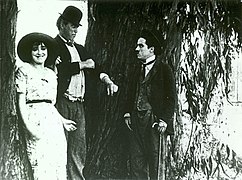Keystone Studios
34°05′10.37″N 118°15′34.80″W / 34.0862139°N 118.2596667°W
 Keystone Studios, 1915 | |
| Industry | Film studio |
|---|---|
| Founded | 1912 (as Keystone Pictures Studio) |
| Founder | Mack Sennett |
| Defunct | 1935 |
| Headquarters | Edendale, Los Angeles |
Keystone Studios was an early
The name Keystone was taken from the side of one of the cars of a passing Pennsylvania Railroad train (Keystone State being the nickname of the Commonwealth of Pennsylvania) during the initial meeting of Sennett, Kessel and Baumann in New York.[6]
The original main building, the first totally enclosed film stage and studio in history, is still standing. It is located at 1712 Glendale Blvd in
Production

The studio is especially remembered for its
In 1915, Keystone Studios became an autonomous production unit of the Triangle Film Corporation with D. W. Griffith and Thomas Ince. Sennett left in 1917 to produce his own independent films (eventually distributed through Paramount), after which Keystone's business declined. Keystone Studios eventually closed after bankruptcy in 1935.[5]

Legacy
Much of the lighting and studio equipment from Keystone was bought by Reymond King, who started the "Award Cinema Movie Equipment" company in
"Keystone Studios" is the fictional studio in the
In 2007, when the independent film studio Cineville merged with the DVD distributor Westlake Entertainment, the companies named their joint enterprise Keystone.[10]
The original Keystone Studios lot was an explorable location, as well as a major plot element, in the 2011 video game L.A. Noire, published by Rockstar Games.
Gallery
-
Charles Chaplin in The Fatal Mallet(1914)
-
Charles Baumann
-
Adam Kessel
-
Keystone Studios building, Echo Park - Present Day
See also
References
- ^ Internet Movie Databse
- ^ Silent Era.com
- ^ "MovieMoviesite.com". Archived from the original on March 4, 2016. Retrieved August 10, 2014.
- ^ Mutual Film Corporation at Silent Era. Retrieved 2012-01-30.
- ^ ISBN 978-0810874596.
- ^ "HOW KEYSTONE GOT ITS NAME". LA Times. January 7, 1917. p. 24 (of Part 3).
- ^ Bengtson, John (2010). Silent Traces: Discovering Early Hollywood Through the Films of Charlie Chaplin. Lobster Films. 11:30 minutes in.
- ISBN 978-0786457076.
- ISBN 978-0786431939.
- ^ Robertson, Willa (2007-07-18). "Cineville, Westlake create Keystone". Variety. Retrieved 2018-08-15.
Further reading
- Lahue, Kalton (1971); Mack Sennett's Keystone: The man, the myth and the comedies; New York: Barnes; ISBN 978-0-498-07461-5
- Neibaur, James L. (2011); Early Charlie Chaplin: The Artist as Apprentice at Keystone Studios; Lanham, MD: Scarecrow Press; ISBN 978-0-8108-8242-3
- Walker, Brent (2009); Mack Sennett's Fun Factory Jefferson, NC: McFarland and Co. ISBN 978-0-7864-3610-1
External links
![]() Media related to Keystone Studios at Wikimedia Commons
Media related to Keystone Studios at Wikimedia Commons




